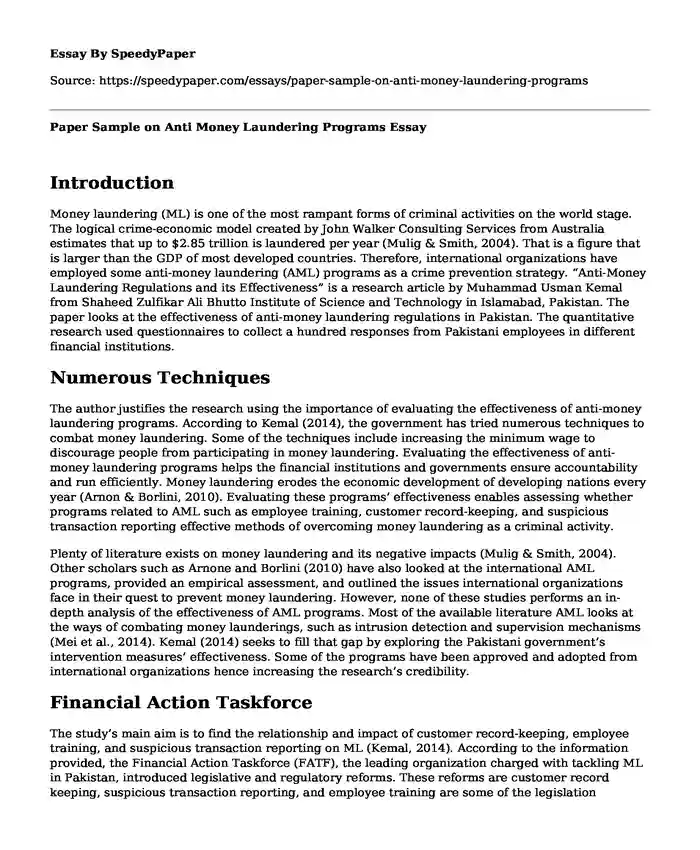
| Type of paper: | Essay |
| Categories: | Criminal law World Money |
| Pages: | 3 |
| Wordcount: | 802 words |
Introduction
Money laundering (ML) is one of the most rampant forms of criminal activities on the world stage. The logical crime-economic model created by John Walker Consulting Services from Australia estimates that up to $2.85 trillion is laundered per year (Mulig & Smith, 2004). That is a figure that is larger than the GDP of most developed countries. Therefore, international organizations have employed some anti-money laundering (AML) programs as a crime prevention strategy. “Anti-Money Laundering Regulations and its Effectiveness” is a research article by Muhammad Usman Kemal from Shaheed Zulfikar Ali Bhutto Institute of Science and Technology in Islamabad, Pakistan. The paper looks at the effectiveness of anti-money laundering regulations in Pakistan. The quantitative research used questionnaires to collect a hundred responses from Pakistani employees in different financial institutions.
Numerous Techniques
The author justifies the research using the importance of evaluating the effectiveness of anti-money laundering programs. According to Kemal (2014), the government has tried numerous techniques to combat money laundering. Some of the techniques include increasing the minimum wage to discourage people from participating in money laundering. Evaluating the effectiveness of anti-money laundering programs helps the financial institutions and governments ensure accountability and run efficiently. Money laundering erodes the economic development of developing nations every year (Arnon & Borlini, 2010). Evaluating these programs’ effectiveness enables assessing whether programs related to AML such as employee training, customer record-keeping, and suspicious transaction reporting effective methods of overcoming money laundering as a criminal activity.
Plenty of literature exists on money laundering and its negative impacts (Mulig & Smith, 2004). Other scholars such as Arnone and Borlini (2010) have also looked at the international AML programs, provided an empirical assessment, and outlined the issues international organizations face in their quest to prevent money laundering. However, none of these studies performs an in-depth analysis of the effectiveness of AML programs. Most of the available literature AML looks at the ways of combating money launderings, such as intrusion detection and supervision mechanisms (Mei et al., 2014). Kemal (2014) seeks to fill that gap by exploring the Pakistani government’s intervention measures’ effectiveness. Some of the programs have been approved and adopted from international organizations hence increasing the research’s credibility.
Financial Action Taskforce
The study’s main aim is to find the relationship and impact of customer record-keeping, employee training, and suspicious transaction reporting on ML (Kemal, 2014). According to the information provided, the Financial Action Taskforce (FATF), the leading organization charged with tackling ML in Pakistan, introduced legislative and regulatory reforms. These reforms are customer record keeping, suspicious transaction reporting, and employee training are some of the legislation introduced to combat ML. According to Kemal (2014), ML is a three-layered process that consists of placement, layering, and integration. Therefore, the first hypothesis was that employee training has an impact on money laundering. It forms the basis for the fourth hypothesis that states there is a negative relationship between employee training and money laundering. It is based on the logic that finance employees will be familiar with the concealment techniques after training.
The second hypothesis is that suspicious transaction reporting has an impact on ML. The second hypothesis forms the basis for deriving the fifth hypothesis, indicating a negative relationship between suspicious transaction reporting and money laundering. The logic behind it that suspicious transaction reporting makes it harder to launder money. The third hypothesis is that customer record-keeping has an impact on money laundering. It forms the basis for the sixth hypothesis, indicating a negative relationship between customer record-keeping and money laundering. The logic behind the hypothesis is that record-keeping enables the analysis and investigation of transactions (Levi & Reuter, 2006).
Conclusion
As a result, the research paper has four variables, one dependent and four independent, that guide research and conclusion. The first variable is money laundering, which is the dependent variable. Customer record keeping, suspicious transaction reporting, and employee training are the independent variables. The study results indicate that there is an inverse relationship between money laundering and employee training. Both suspicious transaction reporting and customer record-keeping have a weak impact on money laundering. The research’s main strength is that the questionnaires are developed using different dimensions of the research variables. The study’s limitation is that it was restricted to Pakistan, making it less applicable to other countries such as the United States.
References
Arnone, M., & Borlini, L. (2010). International antimoney laundering programs. Journal of Money Laundering Control, 13(3), 226-271.
https://www.academia.edu/download/42706108/International_anti_mon.pdf
Kemal, M. U. (2014). Anti-money laundering regulations and its effectiveness. Journal of Money Laundering Control. 17(4), 416-427.
https://www.researchgate.net/profile/Usman_Kemal2/publication/280171998_Anti-money_laundering_regulations_and_its_effectiveness/links/5a81fa10a6fdcc6f3ead6de6/Anti-money-laundering-regulations-and-its-effectiveness.pdf
Levi, M., & Reuter, P. (2006). Money laundering. Crime and Justice, 34(1), 289-375. http://orca.cf.ac.uk/3154/1/Levi%202006.pdf
Mei, D., Ye, Y., & Gao, Z. (2014). Literature Review of International Anti-Money Laundering Research: A Scientometrical Perspective. Open Journal of Social Sciences, 2(12), 111.
https://www.scirp.org/html/15-1760312_52578.htm
Mulig, E. V., & Smith, M. (2004). Understanding and preventing money laundering. Internal Auditing, 19(5), 22-25. https://www.researchgate.net/publication/228302122_Understanding_and_Preventing_Money_Laundering.
Cite this page
Paper Sample on Anti Money Laundering Programs. (2024, Jan 04). Retrieved from https://speedypaper.com/essays/paper-sample-on-anti-money-laundering-programs
Request Removal
If you are the original author of this essay and no longer wish to have it published on the SpeedyPaper website, please click below to request its removal:
- Free Essay about History of Gun Control in America
- Free Essay on History of Europe
- Effectiveness of Online Shopping. Free Essay Example.
- Essay Sample on Legalization of Cannabis in the UK
- Prevention of School Violence - Research Paper Example
- Paper Example: Government Budget Paper
- Essay Sample on Covid-19 and its Effect on the Tourism Industry
Popular categories




